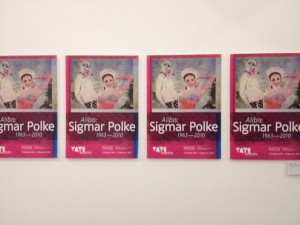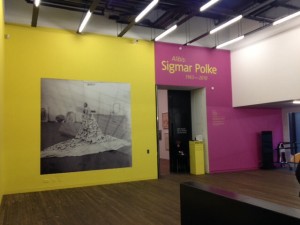Alibis: Sigmar Polke – Tate Modern, London

Polke is a pretty difficult artist to pin down. He worked in media including drawings, paintings, photographs, photocopied images, potatoes, some kind of Perspex, textiles, travel videos, bits of meteor, arrowheads, and the list goes on. While someone like a Richter becomes recognisable through a few major trends in their oeuvre (I’m thinking here of the photorealistic paintings, the later squeegee ones, etc.), Polke’s wide range makes him more difficult for the viewer to comprehend. There are a few common threads to be found, such as an interest in flaws and imperfections, a mistrust of convention and imposed ways of viewing images, a subversion of the post-war German experience and a mocking of the seriousness of conceptual art, but what makes him fascinating is the breadth of ways in which he shared these ideas.
What I enjoyed most about his work was his humour first and foremost, and also some of his experimentations. I liked the early drawings mocking post-war German capitalism, and the picture of superheroes in the supermarket. I really liked the video in which he tried to do a bit of performance art but couldn’t keep a straight face, and was confused/amused by the works depicting attempted seances, one for example with William Blake. In terms of the innovations, some of the pigments he used are fascinating to see, I liked the way he used unfixed photographic chemicals in some of his works so that the images would darken over time, and I even quite liked the photocopier things in terms of what they say about mechanical reproduction and the intent of the artist.
I was torn about some of the parts of the exhibition where he was clearly off his face on something. There was a collaborative artwork from his time in a commune or similar which reminded me slightly of a group project done at camp. There were also his travel videos from a trip to the Subcontinent: I’m not sure that putting performing monkeys to contrasting music elevates them to the status of artworks as compared to the undoubted myriad of similar home movies shot by non-Polkes. He seemed to be enjoying himself though, and many people in the exhibition were watching with interest, so who am I to judge?
I did leave the exhibition feeling that I could now discuss Polke with confidence, which for me is one sign that a retrospective is well crafted and researched. I just need a Baselitz exhibition, and maybe one or two others, and I could complete the post-war German set.

